Deck 14: Delocalized Pi Systems: Investigation by Ultraviolet and Visible Spectroscopy Interlude
Question
Question
Question
Question
Question
Question
Question
Question
Question
Question
Question
Question
Question
Question
Question
Question
Question
Question
Question
Question
Question
Question
Question
Question
Question
Question
Question
Question
Question
Question
Question
Question
Question
Question

Unlock Deck
Sign up to unlock the cards in this deck!
Unlock Deck
Unlock Deck
1/34
Play
Full screen (f)
Deck 14: Delocalized Pi Systems: Investigation by Ultraviolet and Visible Spectroscopy Interlude
1
The LUMO of 1,3,5-hexatriene is: 
A)( )10
B) ( 2)
C) ( 3)
D) ( 4)
E) ( 5)

A)( )10
B) ( 2)
C) ( 3)
D) ( 4)
E) ( 5)
( 4)
2
What would be the expected major product of the following reaction? 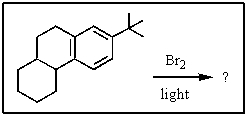
A)
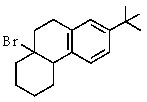
B)

C)
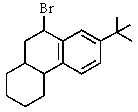
D)
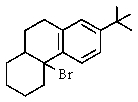
E)
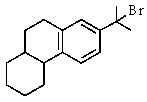

A)

B)

C)

D)

E)


3
What would be the product of the following reaction? 
A)

B)

C)

D)

E) No reaction occurs

A)

B)

C)

D)

E) No reaction occurs

4
UV-visible spectroscopy involves what type of phenomenon?
A) Binding of chemical bonds
B) Electron transitions between orbitals
C) Molecular rotations
D) Nuclear spin transitions
E) Stretching of chemical bonds
A) Binding of chemical bonds
B) Electron transitions between orbitals
C) Molecular rotations
D) Nuclear spin transitions
E) Stretching of chemical bonds

Unlock Deck
Unlock for access to all 34 flashcards in this deck.
Unlock Deck
k this deck
5
A typical Diels-Alder reaction involves
A) an electron-rich diene and an electron-rich dienophile.
B) an electron-poor diene and an electron-rich dienophile.
C) an electron-rich diene and an electron-poor dienophile.
D) an electron-poor diene and an electron-poor dienophile.
E) a non-substituted diene and a non-substituted dienophile.
A) an electron-rich diene and an electron-rich dienophile.
B) an electron-poor diene and an electron-rich dienophile.
C) an electron-rich diene and an electron-poor dienophile.
D) an electron-poor diene and an electron-poor dienophile.
E) a non-substituted diene and a non-substituted dienophile.

Unlock Deck
Unlock for access to all 34 flashcards in this deck.
Unlock Deck
k this deck
6
What product would you expect from the following reaction? 
A)

B)

C)

D)

E)


A)

B)

C)

D)

E)


Unlock Deck
Unlock for access to all 34 flashcards in this deck.
Unlock Deck
k this deck
7
What would be the expected major product of the following reaction sequence? 
A)

B)

C)

D)
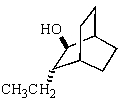
E)


A)

B)

C)

D)

E)


Unlock Deck
Unlock for access to all 34 flashcards in this deck.
Unlock Deck
k this deck
8
What product(s)would NOT be formed from the reaction of 1,3-butadiene with HCl? 
A)

B)

C)

D) neither A nor C
E) neither B nor C

A)

B)

C)

D) neither A nor C
E) neither B nor C

Unlock Deck
Unlock for access to all 34 flashcards in this deck.
Unlock Deck
k this deck
9
What product(s)would you expect the following radical reaction to provide in reasonable yields? 
A)

B)

C)

D) both B and C
E) both A and C

A)

B)

C)

D) both B and C
E) both A and C

Unlock Deck
Unlock for access to all 34 flashcards in this deck.
Unlock Deck
k this deck
10
What would be the final product(s)of the following reactions? 
A)

B)

C)

D) both A and B
E) both A and C

A)

B)

C)

D) both A and B
E) both A and C

Unlock Deck
Unlock for access to all 34 flashcards in this deck.
Unlock Deck
k this deck
11
What would be the major product of the following reaction? 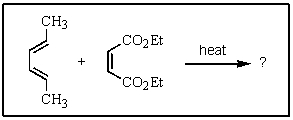
A)
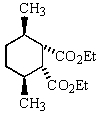
B)
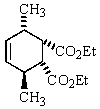
C)
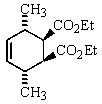
D)

E) None of these products are formed.

A)

B)

C)

D)

E) None of these products are formed.

Unlock Deck
Unlock for access to all 34 flashcards in this deck.
Unlock Deck
k this deck
12
What would be the major product from the following reaction? 
A)

B)

C)

D)

E)


A)

B)

C)

D)

E)


Unlock Deck
Unlock for access to all 34 flashcards in this deck.
Unlock Deck
k this deck
13
What major product would result from the following sequence of reactions? 
A)

B)

C)

D)

E)


A)

B)

C)

D)

E)


Unlock Deck
Unlock for access to all 34 flashcards in this deck.
Unlock Deck
k this deck
14
The reaction of butadiene with acrolien would yield what product? 
A)

B)

C)

D)

E) None of these products are formed.

A)

B)

C)

D)

E) None of these products are formed.

Unlock Deck
Unlock for access to all 34 flashcards in this deck.
Unlock Deck
k this deck
15
The presence of a bromine WHERE in the following carbon chain would give the most reactive material for an SN2 reaction with a nucleophile (all other bonds would be to hydrogen)? 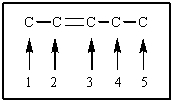
A) 1
B) 2
C) 3
D) 4
E) 5

A) 1
B) 2
C) 3
D) 4
E) 5

Unlock Deck
Unlock for access to all 34 flashcards in this deck.
Unlock Deck
k this deck
16
What product(s)would you expect from the following reaction? 
A)

B)

C)

D) both A and B
E) both A and C

A)

B)

C)

D) both A and B
E) both A and C

Unlock Deck
Unlock for access to all 34 flashcards in this deck.
Unlock Deck
k this deck
17
Which of the following dienes would you expect to be the most reactive in Diels-Alder reactions?
A)

B)

C)

D)

E)

A)

B)

C)

D)

E)


Unlock Deck
Unlock for access to all 34 flashcards in this deck.
Unlock Deck
k this deck
18
In order of decreasing reactivity,how would the bromides below rank in the following reaction? 
A) B > A > D > C
B) D > B > A > C
C) A > C > D > B
D) D > A > C > B
E) C > D > B > A

A) B > A > D > C
B) D > B > A > C
C) A > C > D > B
D) D > A > C > B
E) C > D > B > A

Unlock Deck
Unlock for access to all 34 flashcards in this deck.
Unlock Deck
k this deck
19
What would be the major product of the following reaction? 
A)

B)

C)

D)

E)


A)

B)

C)

D)

E)


Unlock Deck
Unlock for access to all 34 flashcards in this deck.
Unlock Deck
k this deck
20
Which one of the following dienes would you expect to be the most stable?
A)

B)

C)

D)

E)

A)

B)

C)

D)

E)


Unlock Deck
Unlock for access to all 34 flashcards in this deck.
Unlock Deck
k this deck
21
What is the IUPAC name for the following compound? 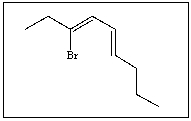
A) (3E,5E)-7-Bromo-4,6-nonadiene
B) (3E,5E)-3-Bromo-3,5-nonadiene
C) (3E,5Z)-7-Bromo-4,6-nonadiene
D) (3Z,5E)-3-Bromo-3,5-nonadiene
E) (3Z,5Z)-3-Bromo-3,5-nonadiene

A) (3E,5E)-7-Bromo-4,6-nonadiene
B) (3E,5E)-3-Bromo-3,5-nonadiene
C) (3E,5Z)-7-Bromo-4,6-nonadiene
D) (3Z,5E)-3-Bromo-3,5-nonadiene
E) (3Z,5Z)-3-Bromo-3,5-nonadiene

Unlock Deck
Unlock for access to all 34 flashcards in this deck.
Unlock Deck
k this deck
22
Which of the structures below do not benefit from resonance stabilization?
A)

B)

C)

D)

E) None of the above.
A)

B)

C)

D)

E) None of the above.

Unlock Deck
Unlock for access to all 34 flashcards in this deck.
Unlock Deck
k this deck
23
What is the proper IUPAC name for the following molecule: 
A) (2E,4Z)-2,4-heptadiene
B) (2E,3Z)-2,3-heptadiene
C) (2Z,4E)-2,4-heptadiene
D) (2E,4Z)-2,4-hexadiene
E) (2Z,3E)-2,3-hexadiene

A) (2E,4Z)-2,4-heptadiene
B) (2E,3Z)-2,3-heptadiene
C) (2Z,4E)-2,4-heptadiene
D) (2E,4Z)-2,4-hexadiene
E) (2Z,3E)-2,3-hexadiene

Unlock Deck
Unlock for access to all 34 flashcards in this deck.
Unlock Deck
k this deck
24
The reaction shown below is expected to produce which product(s)? 
A)

B)

C)

D)

E) more than one of these

A)

B)

C)

D)

E) more than one of these

Unlock Deck
Unlock for access to all 34 flashcards in this deck.
Unlock Deck
k this deck
25
Which of the following alkylbromides cannot be a product of the allylic bromination of 1-methylcyclopentene with NBS?
A)

B)

C)
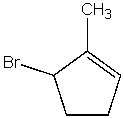
D)

E) All of the above can be a product from the reaction.
A)

B)

C)

D)

E) All of the above can be a product from the reaction.

Unlock Deck
Unlock for access to all 34 flashcards in this deck.
Unlock Deck
k this deck
26
The UV spectrum of the following molecule is useful for determining _______. 
A) coupling constants between hydrogen atoms
B) molecular weight
C) conjugation resulting in electronic transitions
D) molecular formula
E) two of these are correct

A) coupling constants between hydrogen atoms
B) molecular weight
C) conjugation resulting in electronic transitions
D) molecular formula
E) two of these are correct

Unlock Deck
Unlock for access to all 34 flashcards in this deck.
Unlock Deck
k this deck
27
The pi electrons in 1,3-butadiene are distributed as follows:
A) One in each of 4 bonding orbitals
B) Two in bonding orbitals,two in non-bonding orbitals
C) Two in each of 2 bonding orbitals
D) One in each of 4 non-bonding orbitals
E) None of these.
A) One in each of 4 bonding orbitals
B) Two in bonding orbitals,two in non-bonding orbitals
C) Two in each of 2 bonding orbitals
D) One in each of 4 non-bonding orbitals
E) None of these.

Unlock Deck
Unlock for access to all 34 flashcards in this deck.
Unlock Deck
k this deck
28
Predict the product of the following reaction: 
A)

B)

C)

D)

E) No reaction

A)

B)

C)

D)

E) No reaction

Unlock Deck
Unlock for access to all 34 flashcards in this deck.
Unlock Deck
k this deck
29
Which of the following electrocyclic reactions occurs via a conrotatory process?
A)
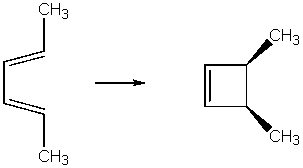
B)
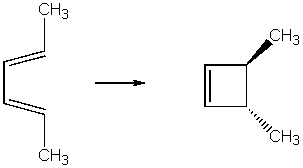
C)
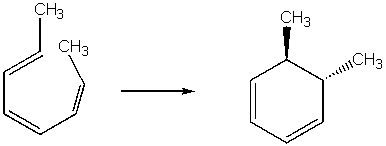
D)

E) Both B and C
A)

B)

C)

D)

E) Both B and C

Unlock Deck
Unlock for access to all 34 flashcards in this deck.
Unlock Deck
k this deck
30
Predict the MAJOR product of the following reaction: 
A)

B)

C)

D)

E) No reaction

A)

B)

C)

D)

E) No reaction

Unlock Deck
Unlock for access to all 34 flashcards in this deck.
Unlock Deck
k this deck
31
When reacted with Br2 and light,which C-H bond 2-pentene will preferentially dissociate to give a radical? 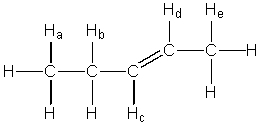
A) The C-Ha bond
B) The C-Hb bond
C) The C-Hc bond
D) The C-Hd bond
E) The C-He bond

A) The C-Ha bond
B) The C-Hb bond
C) The C-Hc bond
D) The C-Hd bond
E) The C-He bond

Unlock Deck
Unlock for access to all 34 flashcards in this deck.
Unlock Deck
k this deck
32
Which is the MAJOR product of combining 1,3-butadiene with HBr at 25 oC?
A) 1-bromo-2-butene
B) 3-bromo-1-butene
C) 1,3-dibromobutadiene
D) 2,3-dibromobutene
E) 3,3-dibromobutene
A) 1-bromo-2-butene
B) 3-bromo-1-butene
C) 1,3-dibromobutadiene
D) 2,3-dibromobutene
E) 3,3-dibromobutene

Unlock Deck
Unlock for access to all 34 flashcards in this deck.
Unlock Deck
k this deck
33
Which of the following are most favored thermodynamically?
A)

B)

C)

D) All of these.
E) None of these.
A)

B)

C)

D) All of these.
E) None of these.

Unlock Deck
Unlock for access to all 34 flashcards in this deck.
Unlock Deck
k this deck
34
Predict the product of the hydrolysis of (S)-4-bromo-2-pentene.
A) (R)-2-pentene-4-ol
B) Racemic 3-pentene-2-ol
C) (R)-2-hydroxy-3-pentene
D) Racemic-3-hydroxy-3-pentene
E) (S)-2-hydroxy-3-pentene
A) (R)-2-pentene-4-ol
B) Racemic 3-pentene-2-ol
C) (R)-2-hydroxy-3-pentene
D) Racemic-3-hydroxy-3-pentene
E) (S)-2-hydroxy-3-pentene

Unlock Deck
Unlock for access to all 34 flashcards in this deck.
Unlock Deck
k this deck



